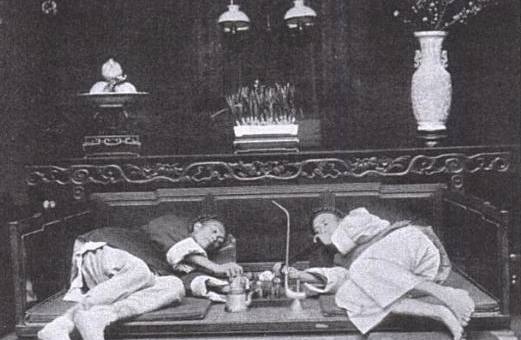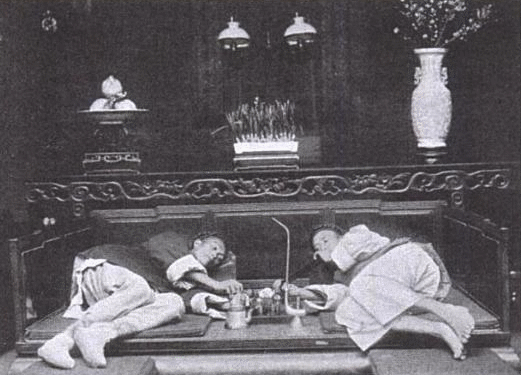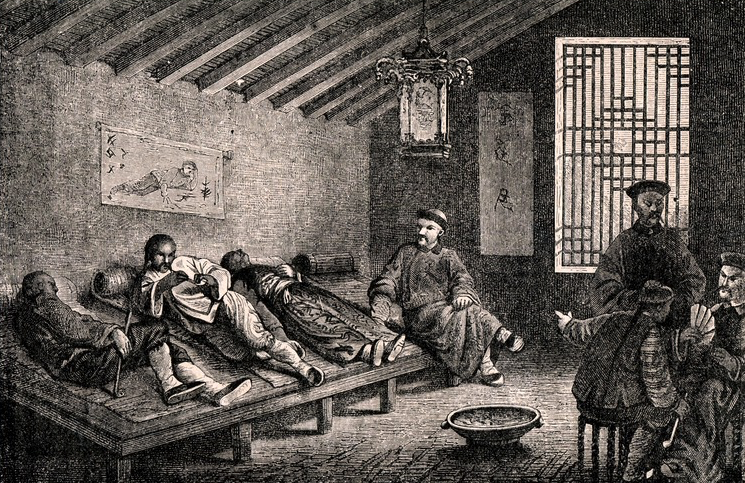
Within the heart of China, hidden amidst the bustling streets of Shanghai, lay the Nan-Gin-Tsin – an opium den of such infamy that its tales transcended borders and eras. While Paris held the heart of Europe in its charming grip, it was Shanghai’s opium dens, that whispered tales of pleasure, decadence, and indulgence.
The Nan-Gin-Tsin

A writer in a recent number of the North China Herald describes the Nan-gin-tsin, the greatest opium den in China. It is known throughout the length and breadth of the empire to the Chinese, and it helps to make Shanghai regarded as a city affording the same opportunities for pleasure and dissipation that Paris does the typical Frenchman.
It is situated in the French concession in Shanghai, within which no opium shops are supposed to exist. The character of the place could not be guessed from its external appearance, although the air of the people passing in and out might suggest it. The throngs visiting it represent all stations of life, from the coolie to the wealthy merchant or the small mandarin.
Inside the Den
It is with difficulty that one gets inside through the crowds of people hanging round the door. Those who have not the requisite number of copper cash to procure the baneful pipe watch with horrible wistfulness each of the more affluent pass in with a nervous, hurried step, or totter out wearing that peculiar dazed expression which comes after the smoker’s craving has been satisfied and his transient pleasure has passed away.

One requires a strong stomach to stand the sickening fumes with which the air inside is thickened. The clouds of smoke, the dim light from the numerous colored lamps, the numbers of reclining forms with distorted faces bent over the small flames at which the pipes are lighted, cause the novice a sickening sensation. But as soon as the eye becomes accustomed to the scene it is noticed that the place is got up on an expensive scale.
In the center of the lower room hangs one of the finest of Chinese lamps, the ceiling is of richly carved wood, while the painted walls are thickly inlaid with a peculiarly marked marble, which gives the idea of unfinished landscape sketches.
Smokers’ Apartments
Numerous doors on all sides lead to the smokers’ apartments. In the outer portion of the building stands a counter covered with little boxes of the drug ready for smoking, which a dozen assistants are kept busy handing out to the servants who wait upon the habitues of the place. The average daily receipts are said to be about $1,000.
Smokers Divided Into Classes
The smoking apartments are divided into four classes. In the cheapest are coolies, who pay about fourpence for their smoke. In the dearest the smoke costs about sevenpence.
The drug supplied in each class is much the same, both in quality and quantity; it is the difference in the pipes that regulates the price. The best kinds are made of ivory, the stem being often inlaid with stones and rendered more costly by reason of elaborate carving; the cheapest kinds are made simply of hard wood.

The rooms also are furnished according to class. In the most expensive the lounge upon which the smoke reclines is of fine velvet, with pillows of the same material; the frames of each couch are inlaid with mother-of-pearl and jade, and the whole air of these rooms is one of sensuous luxury. There is also a number of private rooms.
In the poorer sections will be seen many wearers of the tattered yellow and gray robes of Buddhist and Taoist priests. Women form a fair proportion of the smokers. The common belief is that the opium sleep is attended by a mild, pleasurable delirium, with brief glances of Elysium; but this is the exception, not the rule.
People smoke to satisfy the craving begotten of previous indulgence. There is accommodation for 150 smokers at a time, and there is seldom a vacancy very long. The stream of smoke goes on from early morning till midnight, when the place closes; the clouds of smoke go up incessantly all day long.
Europeans do not often visit the place, but the seamen of American men-of-war visiting Shanghai sometimes seek solace in the drug.
Source: Frostburg mining journal. (Frostburg, Md.), 01 Oct. 1887.

